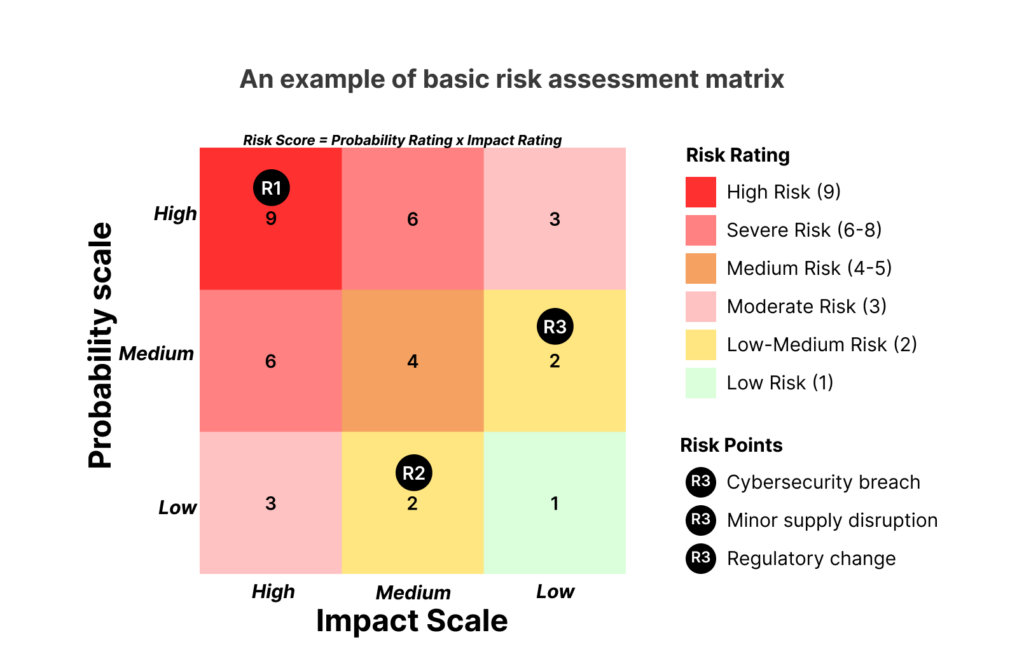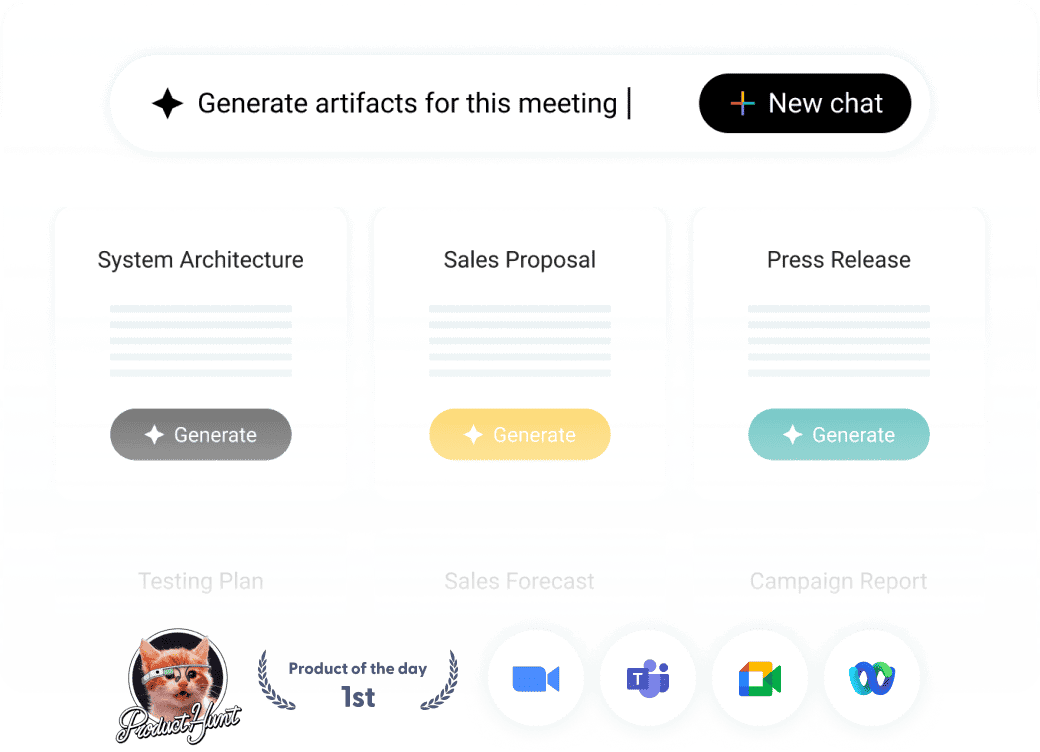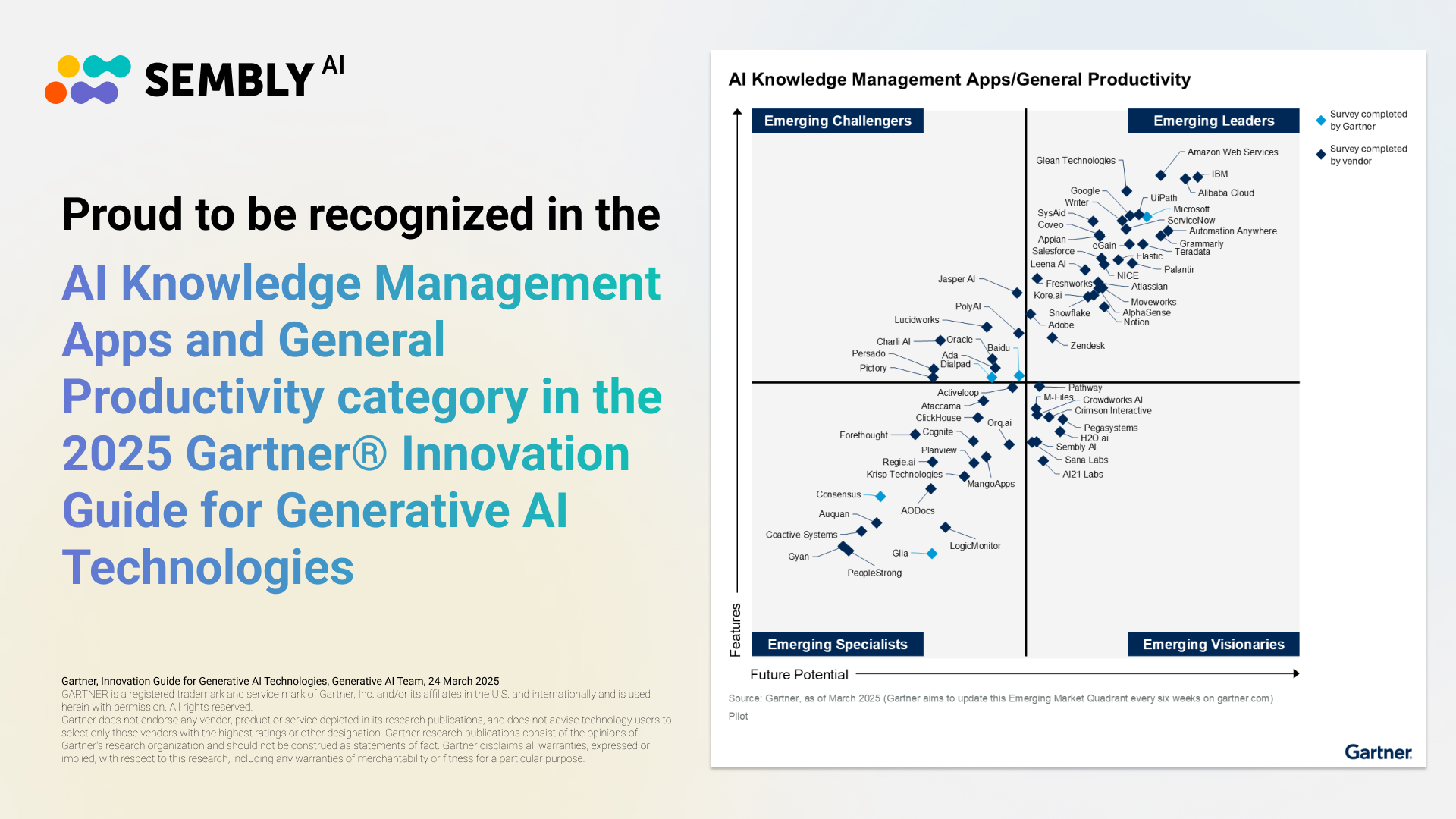Table of Contents
ToggleRecently updated on April 17th, 2025
A certain risk is unavoidable in any business, but measuring it shouldn’t be guesswork. What we will discuss today is one particular way to make sense of these potential threats: a risk assessment matrix. This visual tool ranks risks by probability and severity giving you a clear vision and priorities. And don’t be afraid of “matrix” — there is nothing particularly sophisticated in it (you don’t need to know high-level math for this, for sure).
What challenges is your business most vulnerable to right now? This question haunts every business leader on earth. However, what sets succeeding businesses apart is that they typically identify and address threats before they become problems. That’s where the risk assessment matrix comes in. From market volatility to supply chain disruptions, companies that ignore potential risks often face “unexpected crises,” while matrices can significantly reduce the likelihood of facing them.
The risk assessment matrix helps you evaluate potential problems before they hit your bottom line, and using it is much easier than you might think. So, are you ready to protect your business from preventable disasters? Read on to discover practical risk matrix templates and examples that will strengthen your risk management strategy from day one!
What Is a Risk Assessment Matrix?
Let’s begin with a clear understanding of what a risk assessment matrix is. First, let’s define risk assessment. It is the systematic process of identifying and evaluating potential threats to an organization. Now, let’s demystify the term “matrix”. In this context, the matrix is simply a visual tool—a grid or table—that plots risks according to two factors: how likely they are to happen and how severe their impact would be. A risk assessment matrix combines these elements to categorize threats into priority levels (high, medium, low), making risk data easy to interpret at a glance.
In essence, a risk assessment matrix is a strategic visualization tool that categorizes potential threats by combining their likelihood and impact levels, enabling organizations to quickly identify which risks demand immediate attention and resources.
Why Use a Risk Assessment Matrix?
Risk assessment matrices provide clarity in an uncertain business environment. They help you sort through the noise of potential problems to focus on what truly matters. When facing multiple threats, this practical tool brings order to chaos and creates a shared understanding of risk across your organization.
Here’s why you should use a risk assessment matrix:
- Prioritization: It categorizes threats by risk level, allowing you to tackle the most dangerous issues first rather than wasting resources on minor concerns.
- Communication: The visual format helps key stakeholders understand complex risk scenarios even without specialized knowledge, ensuring alignment on response strategies.
- Resource allocation: By clearly showing which operational risks pose the greatest danger, you can allocate your limited budget and personnel more effectively.
- Prevention focus: The matrix highlights potential consequences before they occur, shifting your approach from reactive to proactive risk management.
- Decision support: The structured evaluation provides data for informed decisions rather than gut feelings about which risks require immediate action.
- Process improvement: Regular updates to your risk assessment matrix support continuous improvement of your risk management process as potential risks evolve.
Key Components of a Risk Assessment Matrix
Risk assessment matrices can be customized to fit your organization’s specific needs. You can select different components depending on your industry, risk tolerance, and management approach. The key is creating a matrix that provides clear insights without overwhelming users with unnecessary complexity. Now, let’s try to build a simple and user friendly risk probability and impact matrix:

Here’s what we need to build this simplest risk matrix example:
Probability Scale
This scale should measure the likelihood of a risk occurring, usually displayed on the vertical axis as High/Medium/Low. The probability of occurrence assessment may be based on historical data, expert judgment, or industry benchmarks. Accurate probability estimation requires input from relevant stakeholders who understand the operational context and potential triggers.
Impact Scale
Impact refers to the negative consequences if a risk materializes. Displayed on the horizontal axis, it assesses severity based on criteria like financial loss, operational disruption, reputation damage, or harm to people.
Risk Score
The numerical value (1-9 in a 3×3 matrix) is calculated by multiplying probability and impact ratings. Risk scores provide quantitative measurement for comparison and prioritization, enabling objective decision-making about resource allocation for risk treatment.
Risk Rating
Color-coded categories that visually communicate threat levels—red for high-risk, light-red for medium-high, orange for medium, rose for moderate, yellow for low-medium, and green for low-risk. These visual cues create an immediate understanding of which risks require urgent attention versus those that can be monitored periodically.
Risk Points
Specific threat identifiers (like R1, R2, R3) plotted on the matrix based on their probability and impact assessments. Each point represents an individual risk facing your organization that has been analyzed and positioned accordingly.
How to Create a Risk Assessment Matrix: Step-by-Step Guide + Examples
The basic 3×3 matrix example shown above is just the starting point. Risk assessment matrices can be way more sophisticated, incorporating additional dimensions like control effectiveness, detectability, or timeframes. You can also expand to 5×5 grids for more nuanced evaluations or develop detailed mitigation strategies with their own templates for each risk level. The most advanced approaches link specific response protocols directly to risk scores, creating a complete risk management system rather than just an assessment tool.
Here’s a step-by-step guide to creating an effective risk matrix:
Define Your Evaluation Criteria
Establish clear scales for probability and potential impact, as mentioned above. For each level, create specific definitions that everyone in your team understands.
Example:
- Impact (Low): Financial loss under $10,000
- Impact (Medium): Financial loss $10,000-100,000
- Impact (High): Financial loss over $100,000
Design Your Matrix Structure
Choose a format that matches your needs (we will provide several risk assessment matrix templates in the next section of the text). 3×3 risk matrices work for simple assessments, while 5×5 matrices provide more granularity for complex environments. Also, you may add mitigation strategies as an additional section to your matrix documentation, ensuring each identified risk has a corresponding action plan.
Note: A visual representation might use color coding to instantly communicate risk levels.
Develop Your Scoring System
Create a formula for calculating risk scores. Multiplying the level of probability by the impact score is a good way to start.
Example: In a 5×5 risk matrix template, your scores should range from 1 (lowest) to 25 (highest)
Set Risk Tolerance Thresholds
Define which scores require immediate actions versus monitoring. This process should involve team goal-setting where key stakeholders establish risk management objectives aligned with broader business goals, creating shared ownership and ensuring the risk analysis matrix serves organizational priorities.
Example:
- Low risk (1-4): Accept and monitor
- Medium risk (5-14): Develop risk mitigation strategies
- High risk (15-25): Immediate action required
Identify and Assess Risks
List all potential hazards and evaluate each one according to your criteria.
Example: For a manufacturing company:
- Supply chain disruption: High probability, High impact = 25
- Power outage: Medium probability, Medium impact = 12
Develop Response Strategies
Create specific risk mitigation strategies for each risk level.
Review and Update
Schedule regular reassessments as conditions change.
Example: Quarterly reviews for high-risk items, annual reviews for the complete risk assessment matrix.
Risk Assessment Matrix Template
Here are three essential risk matrix templates you can copy and use on your own!
5×5 Risk Matrix Template
This advanced risk matrix template allows for a more nuanced risk assessment with five levels of both probability and impact. A 5×5 format provides greater granularity for complex projects where different types of risks need to be carefully evaluated and prioritized.
| Probability/Impact | Negligible (1) | Minor (2) | Moderate (3) | Major (4) | Severe (5) |
| Almost Certain (5) | 5 | 10 | 15 | 20 | 25 |
| Likely (4) | 4 | 8 | 12 | 16 | 20 |
| Possible (3) | 3 | 6 | 9 | 12 | 15 |
| Unlikely (2) | 2 | 4 | 6 | 8 | 10 |
| Rare (1) | 1 | 2 | 3 | 4 | 5 |
Risk Score = Probability Rating x Impact Rating
Risk Rating Legend:
1-6: Low Risk (Green)
7-12: Medium Risk (Yellow)
13-18: High Risk (Orange)
19-25: Extreme Risk (Red)
Risk Assessment Form Template
Another thing that will help us benefit from the risk assessment matrix above is the risk assessment form template. This comprehensive form tracks various types of risks across your project scope, using numeric values to quantify both likelihood and potential impact, just as in previous examples. However, this format also provides a structured approach to documenting risks within established risk management processes showing you how to deal with potential harm.
| Risk ID | Risk Description | Types of Risks | Probability (1-5) | Impact (1-5) | Risk Rating | Mitigation Strategy | Owner | Status |
| R1 | Server outage | Technical | 3 | 5 | 15 (High) | Implement redundant systems | IT manager | Open |
| R2 | Budget overrun | Financial | 4 | 3 | 12 (Medium) | Monthly expense reviews | Finance director | Open |
| R3 | Scope creep | Project | 3 | 2 | 6 (Low) | Clear documentation | PM | In progress |
Mitigation Plan Template
The third template is the most practical. This detailed risk management matrix converts identified risks into actionable strategies, tracking implementation through to resolution. It extends the information captured in the risk assessment form, turning identified threats into concrete action items with measurable outcomes.
| Risk ID | R1 | R2 | R3 |
| Risk Description | Server outage | Budget overrun | Scope creep |
| Risk Type | Technical | Financial | Project |
| Risk Rating | 15 (High) | 12 (Medium) | 6 (Low) |
| Mitigation Actions | Implement redundant systems; Create failover protocols; Test recovery procedures | Implement monthly expense reviews; Create a spending approval process; Set budget alerts | Document project scope clearly; Implement change control; Hold regular scope reviews |
| Required Resources | $125,000; IT team; External consultant | Finance analyst (part-time); Updated expense policy | Documentation template; Change request form |
| Timeline | Q1-Q2 2025 | Immediate implementation | 2 weeks for setup |
| Success Metrics | Zero downtime during failover tests | Expenses within 5% of budget | All changes follow a formal process |
| Owner | IT manager | Finance Director | Project Manager |
| Status | Open | Open | In progress |
Main Types of Risks in Project Management
Now, that we have covered how to create a risk matrix, it’s essential to understand what kinds of threats you might be documenting. Different industries face unique challenges, but certain risk categories appear across most projects and, therefore, across project management itself. Understanding these common project management risk types ensures your risk assessment is comprehensive regardless of particular industry.
| Risk Type | Description | Level of Risk | How to Mitigate |
| Technical Risks | Issues with technology, tools, infrastructure, or technical requirements | Medium-High | Regular technical reviews; Expert consultations; Proof of concepts before full implementation of any project |
| Schedule Risks | Potential for project delays, missed deadlines | Medium | Buffer time in schedules; Critical path analysis; Regular progress tracking |
| Financial Risks | Cost overruns, unexpected expenses | High | Detailed cost estimation; Reserve budget; Regular financial reviews |
| Resource Risks | Inadequate staffing, materials, or capabilities | Medium | Skill gap analysis; Cross-training project team members; Backup resource planning |
| Scope Risks | Scope creep, unclear requirements | High | Detailed requirements documentation; Change control process; Regular stakeholder alignment |
| External Risks | Market changes, natural disasters, regulatory issues, weather | Variable | Environmental scanning; Compliance monitoring; Flexible project planning |
| Operational Risks | Business process issues, workflow disruptions | Medium | Process documentation; Backup operational plans; Training programs |
| AI in Project Management Risks | Algorithm bias, data privacy, governance | Medium-High | Ethical AI frameworks; Continuous monitoring; Human oversight of AI decisions |
Each risk category should be evaluated using consistent risk criteria to determine levels of risk and potential damage to project outcomes.
Examples of Risk Assessment in Different Industries
However, different sectors face unique threats requiring tailored risk assessment. While the basic risk matrix template structure remains consistent, the specific risks and evaluation criteria may vary significantly by industry. A well-designed risk impact matrix is a powerful tool for identifying and prioritizing threats across any business context, and here’s what we can see from the practice of different industries:
IT Industry
Tech projects face rapidly evolving threats across hardware, software, infrastructure, and cybersecurity domains. Cybersecurity risks dominate, with data breaches potentially costing millions while critically damaging reputation. Successful risk assessment in IT requires continuous threat modeling, cross-functional security reviews, and automated monitoring. Leaders of the industry integrate risk assessment directly into development pipelines and conduct regular penetration testing. Strategic risks include technology obsolescence and misalignment with business objectives.
Finance Sector
Financial organizations face intricate regulatory compliance risks alongside market volatility. Successful risk management in finance combines quantitative models with stress testing against multiple scenarios. The most effective risk assessment matrices here should weigh liquidity and counterparty risks appropriately while incorporating regulatory change forecasting. Forward-thinking firms integrate real-time market data with automated alert thresholds to enable rapid response to emerging threats.
Legal Field
Law firms and legal departments primarily face client confidentiality risk, regulatory compliance issues, and precedent-setting case outcomes. Effective risk assessment in a legal context employs case categorization by exposure level and establishes clear client acceptance criteria. Successful firms implement rigorous document handling protocols with automated deadline tracking. Strategic risks also involve reputation management and practice area diversification, so many leading firms conduct regular portfolio reviews to ensure balanced risk exposure across practice areas.
Sales Operations
Sales organizations face forecast accuracy risks, pipeline quality issues, and competitive threats. High-performance sales teams implement formal opportunity scoring criteria and automated pipeline quality metrics. Successful risk assessment in sales operations quantifies customer concentration metrics and tracks competitive displacement ratios. Personal selling approaches may also introduce inconsistent messaging that creates fulfillment challenges, so leading organizations develop standardized sales playbooks and implement regular call monitoring to minimize execution risk and ensure customer expectations align with actual delivery capabilities.
Software and Tools for Risk Assessment
Do you know what can significantly simplify the entire risk assessment process? AI! Creating a risk matrix manually still requires substantial time, but artificial intelligence now offers powerful solutions that automate risk identification, analysis, and monitoring. These tools can process vast amounts of data to detect patterns humans might miss, while ensuring consistent application of risk criteria across projects.
Sembly AI represents the cutting edge of this technology. Sembly is a meeting intelligence platform that automatically attends, records, and analyzes your meetings across platforms like Zoom, Microsoft Teams, and Google Meet. The system specifically identifies risks mentioned during long conversations, tagging and categorizing potential threats without manual intervention. These AI meeting minutes ensure that casual mentions of potential problems aren’t lost in the flow of the discussion.
Semblian 2.0, an advanced add-on for Sembly, takes risk management with specialized features. The system creates comprehensive RAID registers (Risks, Assumptions, Issues, Dependencies) automatically from meeting content. Instead of struggling with how to create a risk matrix manually, teams can generate an AI risk assessment matrix that complies identified threats across multiple meetings automatically. This means you can automatically create fully customized risk assessment matrix documents based on your team’s discussions, with no manual data entry required. The system extracts risk details directly from conversations and formats them into ready-to-use matrices.
This AI risk assessment matrix approach continuously updates as new risks are discussed, providing real-time threat monitoring. The platform allows teams to quantify risks by probability and impact, automate mitigation strategy tracking, and maintain a complete audit trail of risk-related discussions—all essential for compliance and governance requirements.
FAQs
What is a risk assessment matrix?
Risk assessment matrices are visual tools that plot potential threats based on their probability and impact, allowing organizations to prioritize which risks need immediate attention versus those that can be monitored or accepted. In our article, we provided a risk assessment matrix with examples on how to use it.
What’s the best way to create a risk matrix template for my organization?
The best risk matrix template should combine simplicity with relevance to your specific industry. Start with a basic 3×3 or 5×5 grid plotting probability against impact. Define clear criteria for each level (e.g., high probability = >70% chance). Customize color coding for different risk levels and include spaces for risk IDs, descriptions, and mitigation strategies. For complex environments, consider using specialized tools like Sembly for creating an AI risk assessment matrix that can automatically update as new information emerges.
How can AI improve my risk assessment process?
AI risk assessment matrices automate risk identification, saving time while catching more potential threats. Tools like Sembly detect risks mentioned in meetings and compile them into structured frameworks. The best AI risk assessment matrix solutions update continuously, quantify risks consistently, and link directly to mitigation plans—typically identifying 30-40% more risks than manual methods.
What makes an effective risk matrix example for project management?
A useful risk matrix example balances simplicity with adequate detail. The best risk assessment matrix template includes clearly defined probability and impact scales (typically 3×5 or 5×5), color-coding for quick visual assessment, consistent scoring methodology, and space for mitigation strategies and ownership assignment.
Introducing Semblian 2.0
- ✦ Multi-Meeting Chats
- ✦ AI Insights
- ✦ AI Artifacts









